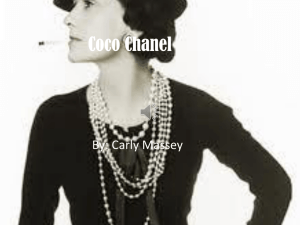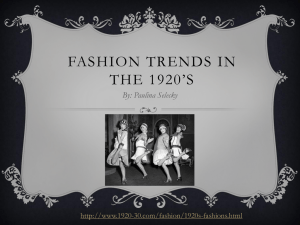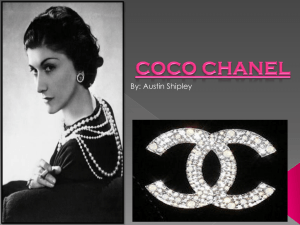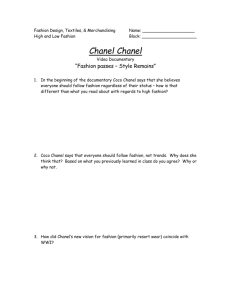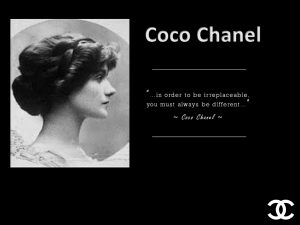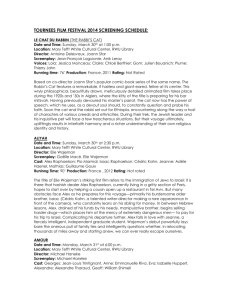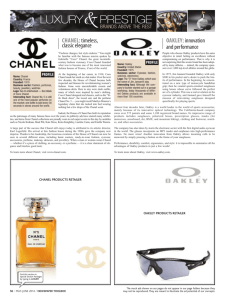Relationship between Designer and Company: Coco Chanel and
advertisement
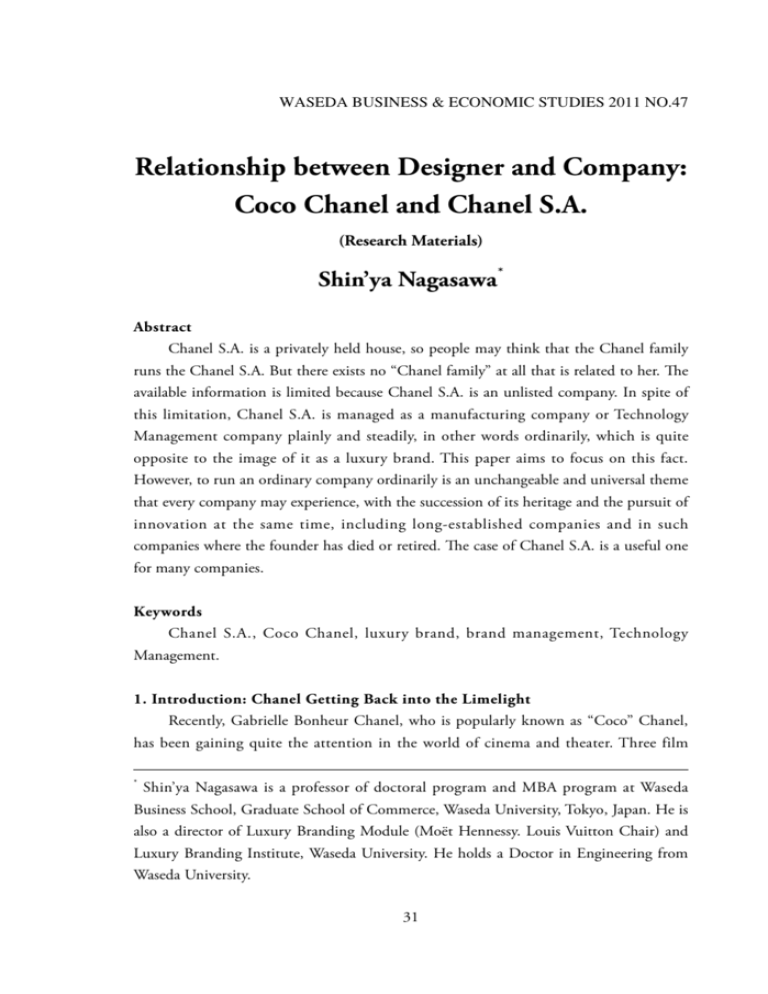
WASEDA BUSINESS & ECONOMIC STUDIES 2011 NO.47 Relationship between Designer and Company: Coco Chanel and Chanel S.A. (Research Materials) Shin’ya Nagasawa * Abstract Chanel S.A. is a privately held house, so people may think that the Chanel family runs the Chanel S.A. But there exists no “Chanel family” at all that is related to her. The available information is limited because Chanel S.A. is an unlisted company. In spite of this limitation, Chanel S.A. is managed as a manufacturing company or Technology Management company plainly and steadily, in other words ordinarily, which is quite opposite to the image of it as a luxury brand. This paper aims to focus on this fact. However, to run an ordinary company ordinarily is an unchangeable and universal theme that every company may experience, with the succession of its heritage and the pursuit of innovation at the same time, including long-established companies and in such companies where the founder has died or retired. The case of Chanel S.A. is a useful one for many companies. Keywords Chanel S.A., Coco Chanel, luxury brand, brand management, Technology Management. 1. Introduction: Chanel Getting Back into the Limelight Recently, Gabrielle Bonheur Chanel, who is popularly known as “Coco” Chanel, has been gaining quite the attention in the world of cinema and theater. Three film * Shin’ya Nagasawa is a professor of doctoral program and MBA program at Waseda Business School, Graduate School of Commerce, Waseda University, Tokyo, Japan. He is also a director of Luxury Branding Module (Moët Hennessy. Louis Vuitton Chair) and Luxury Branding Institute, Waseda University. He holds a Doctor in Engineering from Waseda University. 31 depictions of the biography of Coco Chanel were released in Japan one after another between the summer of 2009 and beginning of 2010. Here are the three films in the order of release. • “Coco Chanel,” starring academy award winning actress Shirley MacLaine as an older Coco (produced jointly by the U.S., Italy and France and distributed by PiX); • “Coco Before Chanel,” a French film starring actress Audrey Tautou as a young Coco (distributed by Warner Bros.); and • “Coco Chanel & Igor Stravinsky,” a French film starring Anna Mouglalis tracing the love affair between Coco and a Russian composer Igor Stravinsky along with the creation of the famed perfume Chanel “No. 5” (distributed by Hexagon Pictures) The latter two films actually brought Chanel’s current head designer Karl Lagerfeld on board in order to faithfully reproduce the costumes and accessories of the 1910s and 1920s. In addition to their involvement in the films, Tautou and Mouglalis have both become the muses (spokesmodels) to the Chanel brand, Tautou representing the perfume “No. 5” and Mouglalis the perfume “Allure Sensuelle” and the “Premiere” watch collection. The increasing popularity toward Coco Chanel in the film industry is based on two factors: • Popularity in France toward biographical feature films, which started with the movie portraying the great singer Edith Piaf and followed by the life stories of writer Francoise Sagan, philosopher Simone de Beau-voir and singer-songwriter Serge Gainsbourg; and • Reassessment of the brand Chanel due to Coco’s 125th anniversary and the brand’s around-centennial celebrations. Furthermore, with the opening of theatrical play “Gabrielle Chanel” starring Mao Daichi and the musical “Coco” starring Ran Otori, the movies and theaters in Japan seemed to have been taken over by Chanel since the summer of 2009. Such attraction was credited to the fact that Coco’s social circle included famous figures such as playwright Jean Cocteau, painter Pablo Picasso and songwriter Igor Stravinsky and her active love life including the romance with Stravinsky and marriage proposal from the Duke of Westminster following the death of “her soul mate” Arthur Capel. After due consideration, Coco turned down the Duke’s proposal with the famous saying “There have been several Duchesses of Westminster but there is only one Coco Chanel.” Several other quotes of hers have also become very popular. Aside from her losing Capel, Coco would find herself struck with unfortunate events involving her lovers whenever she was about to find happiness, as seen in the case 32 of unexpected death of illustrator Paul Iribe. For this reason, she was often referred to as a “woman carrying the fate of Leo” or a “Leo woman,” which actually was incorporated into the Japanese title of one of her many biographies. She overcame her fate through her passion toward work. The designs and fashion invented by Coco Chanel are often said to have liberated women’s body and mind that were controlled by men and presented a new way of life and new style to women. Many appraise her as an independent female icon of the 20th century in terms of her private life and career. However, some may argue that had it not been for the resources of her patrons and influences from men, she couldn’t have been able to start the business and keep it going. Perhaps this kind of contradiction and dilemma has stirred up the interest and motivation of producers and directors to make movies about her life. In other words, Coco Chanel has provided a film-worthy juicy lifestyle with her dramatic romances, glorious social circle and design and fashion that capture the hearts of many women. If, for example, Coco Chanel invented non-fashion items like computers, industrial machinery and bulldozers, she probably would have still gained respect and appraisal but her story probably would not have become a film. Also, other female fashion designers such as Jeanne Paquin, Callot sisters and Madeleine Vionnet would have not made the same impact as Coco Chanel in films because their names, let alone their life stories, are known only by few in the fashion industry. It would be a challenge to make an interesting movie based on them. In the history of fashion and design, there are many influential female figures besides Coco Chanel. They include Madame Paquin, who founded the base for modern couture by starting the first woman-run fashion house in Paris at the end of 19th century, Callot sisters, who brought luxury and elegance to fashion, Madeleine Vionnet, who is also known as “Queen of the bias cut” and represents the early 20th century designers (couturière). Together with the prestigious Paul Poiret, a male designer known for his clothing cut along straight lines to form natural drapes, the contributions of these women to the fashion industry are honored on the sidewalk mosaic on the corner of Avenue Montaigne and Rue François 1er, an area known as the center of high-end fashion. They were all active from the 1920s to 1930s and made Avenue Montaigne flourish during the thriving Belle Époque. Located on the south corner of the intersection is a Chanel boutique right on Avenue Montaigne (opened in 1983). Back in the day, Coco Chanel only had a store on Rue Cambon and did not have anything to do with the fashion 33 movement on Avenue Montaigne. So why is Coco now capturing people’s hearts and not them? Is it because they are deceased people whose work was recognized in the past? They were actually active around the same time as Coco Chanel and were prominent in the fashion industry. Also, it has been about 40 years since Coco Chanel passed away. In fact, Poiret started his career before Coco did. Best known for freeing women from corsets, he was even hailed as the “King of fashion” at one point. However, his style started to appear out of fashion in front of Coco’s new designs. His fashion house ended up going through bankruptcy and he died in poverty. On the other hand, the Chanel brand is still maintaining its dazzling image even after the company has been passed down through generations of owners after Coco Chanel’s death. This is probably why people’s eyes are on Chanel. 2. The Life of Coco Chanel The following provides a short summary of Coco Chanel’s 87 years of life. Note that the episodes for which the authors retraced the footprints accompany pictures and are written with a bit more passion. Although there are no memoirs written by Coco herself, there are a few biographies written based on the interviews with Coco when she fled to Switzerland and when the Chanel brand made a comeback. Her glamorous and legendary lifestyle filled with scandals had provided excellent material for over 40 books. However, not all of them share the same view of the facts. Some contribute this largely to the fact that Coco changed her stories around at interviews, not just because she was getting old and her memory was getting hazy, but more because she did not want to talk about the truth for some topics. For example, she had mentioned that her father was a descendant of the royal family even though he was actually a street peddler and she dressed up the story or did not discuss any inconvenient details, such as those pertaining to her experience about the time when Paris was under Nazi occupation. Therefore, there are a number of disclaimers in this paper whenever authors found conflicting facts in different documents. 2.1 From Birth to Becoming a Designer —— “Coco avant Chanel” Released in April 2009 in France and in September 2009 in Japan, the French movie “Coco before Chanel” was a great success. The movie depicts the first half of Coco’s life where she meets the love of her life Capel, goes through his sudden death and overcomes the loss to become a successful designer. The original French title is “Coco avant Chanel,” where “avant ” in French means “before” in English. The title itself is 34 Photo 1. The morning market at Avenue du Général de Gaulle in Saumur, the birthplace of Gabrielle Chanel (taken by the author in August, 2009) pretty clever and classy, since the movie portrays the life of post-Chanel Coco that very few know. Gabrielle was born a Leo (which is a fact included in the title of one of the biographies) on August 19, 1883, to a mother in delicate health and a father who was a street peddler dealing with soaps, brushes and other toiletry items. The couple had three daughters and three sons (although some documents say they had five children all together). Some records state that she was born in the Auvergne region, where she worked at a café as a singer, but the truth is that she was born in Saumur in the Loire region. Located by the Loire River, Saumur is well-known for vineyards, wine and an equestrian school, but not so much as a tourist destination. It was a town with stores for locals and busy early-morning markets. The picture of a morning market in Saumur, the birthplace of Gabrielle, is shown in Photo 1. In the foreground of Photo 1 is a produce vendor selling fruits and vegetables next to a butcher who had a stand using the back of his truck loaded with a refrigerated case. Gabrielle’s father probably was a stall keeper in this town just like them. The family lived on the top floor of the apartment located on 29 Rue Saint-Jean in the center of Saumur. Unfortunately, we were not able to go inside and there were no monuments or signs indicating that this was her house. Following the death of their mother, Gabrielle and her two sisters were dropped off at a convent for orphans in Aubazine, Limousin by their father. He never came to visit 35 (a) Façade (b) The area in front of the stairs where Coco sang Photo 2. The bar/brasserie named “Le Grand Café” where Gabrielle-turned Coco worked as a singer still remains in Moulins to this day (taken by the author in August, 2009) them and literally abandoned them. After Gabrielle left the orphanage, she lived with her younger aunt Adrienne (some say she was one of Gabrielle’s sisters) that grew up together in the orphanage in the town of Moulins located in the Auvergne region in central France. She made a living as a seamstress and a singer. Gabrielle Chanel acquired the nickname Coco, possibly due to the cry “Coco!” from the drunk audience, which included the retiring Étienne Balsan and other officers 36 and soldiers, when she sang two songs in her repertoire: the song about a lost dog “Qui qu’a vu Coco dans le Trocadéro? ” (“Who has seen Coco in the Trocadéro?”) and the chanson “Ko-ko-ri-co ” (“Cock-a-doodle-doo”). The bar/brasserie named “Le Grand Café” where Gabrielle-turned Coco worked as a singer still remains in Moulins to this day. The picture is shown in Photo 2. Moulins is located in the suburbs where not even many French know. It is not even listed in most travel guides. Although introduced in the guidebook for Moulins area as a place where the art deco interior dating back to 1899 can be enjoyed, it does not mention that this was the place where Coco sang. However, we confirmed it as true through the tourist information booth and the staff at the café. The waitress even pointed at the area in front of the stairs to tell us where she sang. With the interior that remains the same, the place captured in Photo 2 is indeed the place where Coco stood to sing and was showered with the audience’s affection. Many biographies mention that Coco sang at a cabaret or a nightclub so we imagined a run-down bar that no longer existed. We went to see it with our own eyes without much expectation, but the place was actually nice and is considered as one of the destinations in Moulins. Although no one sings there any more, the original art deco interior decoration still appears very glamorous even after more than 100 years, reminding us that the place was the best café chantant (a place where customers can enjoy a light meal and alcohol while watching singing and dance performances) in Moulins at the time. After her aunt Adrienne married a wealthy man, Coco moved to live in the chateau owned by her patron Balsan, who managed a racing stable near Compiègne outside of Paris, and became a kept woman. Later she met English businessman Arthur “Boy” Capel through Balsan and fell in love. The love was mutual but Capel ended up marrying an aristocratic woman for wealth. Coco accepted the reality and remained as Capel’s mistress. Capel was the one that financed Coco’s first shop. 2.2 Period between Establishment of Business and Temporary Closure (1939) In 1909, with the help of her patron Balsan who gave her the nickname, Coco opened a small millinery atelier shop at 160 Boulevard Malesherbes. (Some documents suggest that it was in 1908 that she opened the boutique and that it was financed by Capel.) After leaving Balsan, Coco fell in love with Capel, who encouraged her to set up a millinery boutique named “Chanel Modes” at 21 Rue Cambon in 1910. (There are different stories regarding the financing of the boutique. Some say that Capel bought the 37 Photo 3. The current photo of the original Chanel store on Rue Cambon in Paris (taken by the author in October, 2008) place or just invested in her, while others say that Coco paid him back right away.) The original boutique moved a few stores down at 31 Rue Cambon and was expanded in 1921 (some suggest this happened in 1919 or 1920). The above Photo 3 is the current photo of the original Chanel store on Rue Cambon in Paris. In 1913 (some say it was in 1914), Coco opened a new boutique in a resort town called Deauville in the Normandy region. It was her second store but the very first that sold clothes designed by Coco. We went to Deauville only to find out that the Chanel boutique no longer exists. The boutique was set up right next to a casino on Rue Lucien Barrière and neighbored the prestigious hotel “Normandy Barrière” where the movie “A Man and a Woman: 20 Years Later,” directed by Claude Lelouch and musical score composed by Francis Lai, was shot. As of 2009, the location has turned into a specialty store for men. According to the tourist information at Deauville, the boutique only operated for a few seasons after 1913 and was relocated back to the store in Paris. This corresponds to the fact that the store on Rue Cambon started dealing in haute couture instead of hats in 1916. Some documents say that the boutique in Deauville opened in 1912 but this must be an error. Following the completion of both the casino and the hotel “Normandy Barrière” in 1912, Coco and Capel visited Deauville together to see the ocean for the first time and they loved the location. It makes more sense to assume that they decided to open the boutique the year after. As a side note, the locals were very excited about the 38 Photo 4. Dress from around 1927 (the little black dress) (conserved by the Kyoto Costume Institute taken by Takashi Hatakeyama) scene in “Coco before Chanel” where Coco and Capel come to Deauville and dance at the casino, which is played again towards the end when Coco looks back on her memories with Capel. Coco opened the boutique with the financial help from Capel and when business was about to roll, Capel died suddenly of a car accident in 1919. Although devastated by her lover’s death, Coco continued to create innovative designs and achieved success as a famed couturière. Photo 4 shows the little black dress to be discussed in the forthcoming paper designed by Coco during this time frame. As mentioned earlier, Coco was friends with many renowned artists and her romantic life was full of drama. While her love life was taking a bumpy road, business was booming. By 1939, her venture had grown to have over 4,000 employees. 39 Photo 5. Beau-Rivage Palace, where Coco stayed in Switzerland living in exile (taken by the author in June, 2009) 2.3 Blank Period between Closing to Living in Exile Amid her success, Coco suddenly left the center stage. This is the beginning of the blank period until she makes a comeback 15 years later. Due to strikes organized by workers based on the forced hard labor prior to the collection and the outbreak of World War II in 1939, Coco decided to close all the boutiques except for the one on Rue Cambon that carried perfume and accessories. Coco stayed in Rue Cambon when Germany occupied France in 1940. She later became romantically involved with the German beau Officer Hans von Dincklage. Following the Liberation of Paris in 1944, Coco moves to Lausanne, Switzerland to live in exile. The author went to Lausanne to locate the hotel Coco stayed in her exile in Switzerland and to find her grave. The luxury hotel called Beau-Rivage (“beautiful shore”) Palace situated on the shore of Lake Geneva is shown in Photo 5. Beau-Rivage Palace was an extremely luxurious hotel comparable to the Ritz, the hotel in Paris where Coco spent her late years and died. Her “faithful companion” with whom she lived in exile is said to be buried in the dog cemetery on the properties of Beau-Rivage Palace. The author assumes that this “faithful companion” referred to Dincklage but unfortunately the inscription was not decipherable due to wear and tear on the gravestone. 2.4 From Coco’s Comeback to Her Death In 1954, Coco, then over 70 years old, made a comeback after 15 blank years in her 40 Photo 6. The entrance of the prestigious Hotel Ritz facing Place Vendôme, the hotel where Coco spent her later years. (taken by the author in March, 2008) career. Christian Dior’s Corolle Line that debuted in 1947 was called the “New Look,” featuring a signature look of dresses that resembled circlets of flower petals and stood by stark contrast to the simple “little black dresses” designed by Coco. Legend has it that Coco said bitterly, “He instantly reversed everything that took me 30 years to chip away.” Coco’s comeback must have been triggered by her strong desire to return to the center stage and also her impression that the public repulsion against her based on her speech and behavior during the war had calmed down. However, the feeling of dislike still remained in the public mind and her fashion was roundly dismissed as being designed by “a relic of the 1930s.” However, as the saying goes, one man’s trash is another man’s treasure. Chanel’s return was enthusiastically supported by Americans, who appreciated its style suitable for active women. The store on Rue Cambon reopened and the business started to move into gear. Around 1934, Coco moved her residence from the apartment above the couture house at Rue Cambon to Hotel Ritz across the street. On January 10, 1971, after a long night of working to prepare for a collection, she retired to bed and passed away in her sleep. She was 87 years old. The photo of the prestigious Hotel Ritz where Coco spent her later years is shown in the following Photo 6. As seen in Photo 6, the entrance of Hotel Ritz is facing Place Vendôme but it is said that Coco’s room was facing the other direction, looking over the couture house on Rue 41 Photo 7. C oco’s gravesite at the cemetery located in Bois-de-Vaux in Lausanne (taken by the author in June, 2009) Cambon. Coco was burried in Lausanne where she lived in exile. Photo 7 shows Coco’s gravesite at the cemetery located in Bois-de-Vaux (Forest of Vaux province) in Lausanne. According to the website of Chanel, born a Leo, Gabrielle Chanel surrounded herself with statues of lions in wood, silver, bronze or alabaster at her apartment at 31 Rue Cambon. The lion became a timeless biographical seal on a number of the creations of Coco, who said “I was born under the sign of Leo. I am a Leo.” Representing her birth sign of Leo, Coco’s tombstone is carved with five stone lion heads. There are five probably because the brand Chanel’s association with the number five. The white flowers are wax begonias (Begonia Semparflorens-Cultorum), blooming in clusters to decorate her gravesite. Coco encouraged others to copy her designs. She said “Just like begonia, which is more beautiful when the flowers are abundant, copies of good design should be plentiful in town.” The deciding factor for planting begonias around her gravesite was probably based on this comment. 3. Two Chanels: Coco Chanel and Chanel S.A. As mentioned earlier, Chanel has captured the hearts of many now because of people’s curiosity and interest in Coco herself. The focus of this paper is not just on Coco as a designer but also Chanel as a company. Chanel was founded by the designer Coco Chanel. Some say she was the most 42 powerful business figure in the 20th century. While others may beg to differ, they probably will agree that she is one of the most influential female entrepreneurs of the 20th century. Therefore, when we mention to the company Chanel, it is inseparable from the life of the designer/entrepreneur Coco Chanel. This refers to the years from 1883 when she was born as a Leo in August to 1971 when she passed away at the age of 87. It is not like her ghost is still running the company nor designing clothing. Coco Chanel’s life story, especially that involving romance, is well-known and has been recounted in a number of books, movies and plays. They all give an account of how the products she designed came about and ended up gaining popularity. This paper is written based on such biographies. Not to mention, all accounts on Coco Chanel-related stories end with Coco Chanel’s death. It is not a total exaggeration to say that this paper writes about Chanel as a company after Coco Chanel’s death up to today. While the movie was about “Coco avant (before) Chanel,” this paper involves “Chanel après (after) Coco.” In other words, this paper focuses on how Coco’s work life (i.e. her life minus the glorious and scandalous love affairs) has affected the development of the company and the brand and on how her philosophy has been carried on to this day. When Coco Chnel was still alive, the Chanel brand, or even the company itself, was synonymous with the founder/designer Coco. However, if that was truly the case, the brand and the company would have died after Coco’s death. It is not clear what Coco had in mind about the future of the Chanel brand and the company after her passing. No biographies mention that she was feeling worried or concerned about how her death would impact Chanel. It does not appear that she had done any preparation or provided any training to someone to be her successor even when she became older. Regardless of whether she was in denial or just simply did not care, Coco did not express her thoughts on the future of the Chanel brand or company after her death in any way. Coco should not be criticized for this as other designers before or during her time all ended their labels in one generation. The brand Christian Dior was one exception to this; after the death of Monsieur Dior, the label lived on by appointing Yves SaintLaurent as the chief designer, who was replaced later with Marc Bohan. Karl Lagerfeld, who became the chief designer for Chanel after Coco’s death, is not a family member of Coco. Currently the fashion division of the Chanel brand is almost synonymous with Karl’s work but he does not have much to do with the division for 43 watches and jewelry or the one for fragrance and basic cosmetics. Furthermore, Chanel did not fully enter into the markets for watches and skin care products among other cosmetics until Coco’s death. The decision was solely based on the current management and not on Coco’s consent nor will. For this reason, analyzing the actions taken by the management in the post-Coco era helps to understand the basis of a brand, the essence of luxury and the survival, succession and development of a business that can be beyond a mere company’s operation. Among various suggestive points, it provides an excellent case for incorporating luxury strategies, which are different from mere fashion strategies or premium strategies. The luxury strategies supported by Chanel can be applied to all companies involved in manufacturing products including the local industries and traditional arts. The main objective of this paper is to communicate that as a fact. From the perspectives above, this paper examines the post-Coco Chanel as a company. 4. Hidden Company “CHANEL” The expression “unknown company Chanel” may cause some arguments. It is well-known that Karl Lagerfeld (often referred to as Karl, because he is also called “Kaiser (Emperer) Karl”) has been with Chanel as the brand’s chief designer (artistic director, to be exact) since 1983. Although originally from Germany, he is a French designer in a practical sense as he worked and resided in France for years. There are many famous products that stand out from the Chanel brand, including the signature “Chanel Suit” made of tweed, quilted Chanel bags with distinctive metallic chain straps, beige bi-color shoes with a black front, the ever-famous perfume “No. 5” and the recent J12 watches with a classy ceramic dial. The haute couture and prêt-àporter collections designed by Karl Lagerfeld are well-known as well. Since Chanel products have high price tags, few people may own multiple items and have first hand experience through frequent usage, but there must be many women especially in Japan that know enough about the brand by owning only one or two Chanel bags or accessories. The website of Chanel proudly says “Chanel is the ultimate House of Luxury.” and “View the latest Couture, Ready-to-Wear, Accessories, Watch and Fine Jewelry Collections. Shop the very best of fragrance, makeup and skincare.” Also, the Chanel website says “View the latest Couture, Ready-to-Wear, Accessories, Watch and Fine 44 Jewelry Collections. Shop the very best of fragrance, makeup and skincare” And shows the various product lines of the brand so it is pretty clear what the brand offers. However, who is it that runs the company? Karl Lagerfeld is the artistic director and not the CEO. How about the headquarters? Many people may think the store on Avenue Montaigne is the main store since it is large and highly visible. However, the main store is the one on Rue Cambon, which was the original boutique. According to some sources, artisans work in the studio above the Rue Cambon store to construct and sew clothing based on Karl’s fashion sketches when getting ready for collection. The website and brochure of Chanel shows the location of the boutique but not the company profile. Chanel S.A. is an independent house and does not belong to a conglomerate such as LVMH or Richemont. Because Chanel S.A. is a privately held house, people may think that the Chanel family runs the Chanel S.A. In fact, “Coco” Chanel grew up in a home for orphans and after she left her sisters she had no relatives. Though her love affairs were brilliant, “Coco” Chanel did not get married and she had no children. Therefore there exists no “Chanel family” at all that is related to her. The available information is limited because Chanel S.A. is an unlisted company. In spite of this limitation, Chanel S.A. is managed as a manufacturing company or Technology Management company plainly and steadily, in other words ordinarily, which is quite opposite to the image of it as a luxury brand. This paper aims to focus on this fact. However, to run an ordinary company ordinarily is an unchangeable and universal theme that every company may experience, with the succession of its “heritage” and the pursuit of “innovation” at the same time, including long-established companies and in such companies where the founder has died or retired. The case of Chanel S.A. is a useful one for many companies. References [1] Kapferer, Jean-Noël, and Vincent Bastien (2009), The Luxury Strategy – Break the Rules of Marketing to Build Luxury Brands –, Kogan Page, London, UK [2] Nagasawa, Shin’ya (2002), An Unpainted Face of the Empire of Luxury Brands: LVMH Moët Hennessy. Louis Vuitton , Nihon Keizai Shimbunsha, Tokyo, Japan (in Japanese) [3] Nagasawa, Shin’ya (2004), An Unpainted Face of the Empire of Luxury Brands: LVMH Moët Hennessy. Louis Vuitton , Taiwan Business Weekly, Taipei, Taiwan (translated in Chinese) 45 [4] Nagasawa, Shin’ya ed. (2007) with Kenji Oizumi, and Kazuaki Maeda, The Principles of Louis Vuitton – The Strongest Brand Strategy –, Toyo Keizai Shinposha, Tokyo, Japan (in Japanese) [5] Nagasawa, Shin’ya (2009a), Creating Customer Experience in Luxury Brands –Comparison of Hermès, Louis Vuitton and Coach –, Waseda Business & Economic Studies , No.44, pp.25-39, Graduate School of Commerce, Waseda University. [6] Nagasawa, Shin’ya (2009b), Marketing Principles of Louis Vuitton – The Strongest Brand Strategy –, Waseda Business & Economic Studies , No.44, pp.41-54, Graduate School of Commerce, Waseda University. [7] Nagasawa, Shin’ya ed. (2009c) with Kenji Oizumi, and Kazuaki Maeda, The Principles of Louis Vuitton – The Strongest Brand Strategy – , Haeng Gan, Inc., Seoul, Korea (translated in Hangul) [8] Nagasawa, Shin’ya ed. (2009d) with Kenji Oizumi, and Kazuaki Maeda, The Principles of Louis Vuitton – The Strongest Brand Strategy – , Technology Promotion Association, Bangkok, Thailand (translated in Thailand language) [9] N agasawa, Shin’ya (2009e), Secrets of Louis Vuitton – Why Louis Vuitton is Tough in Hard Times?– , Kodansha, Tokyo, Japan (in Japanese) [10] Nagasawa, Shin’ya ed. (2010a) with Kana Sugimoto, Chanel Strategy – Management of the Ultimate Luxury Brand – , Toyo Keizai Shinposha, Tokyo, Japan (in Japanese) [11] Nagasawa, Shin’ya (2010b), Luxury Brand Strategy of Louis Vuitton – Details of Marketing Principles –, Waseda Business & Economic Studies , No.45, pp.21-40, Graduate School of Commerce, Waseda University. [12] Nagasawa, Shin’ya, and Kana Sugimoto (2010c), The Succession of Technology and Production of the Technology Management Brand "Chanel," Waseda Business & Economic Studies , No.45, pp.41-55, Graduate School of Commerce, Waseda University. [13] Nagasawa, Shin’ya ed. (2011a) with Kana Sugimoto, Chanel Strategy – Management of the Ultimate Luxury Brand – , Random House Korea Inc., Seoul, Korea (translated in Hangul) [14] Nagasawa, Shin’ya (2011b), Chanel's Devotion and Product Development as a Luxury Brand: Taking R&D and product development of its watch business as an example, Waseda Business & Economic Studies , No.46, pp.25-37, Graduate School of Commerce, Waseda University. 46

